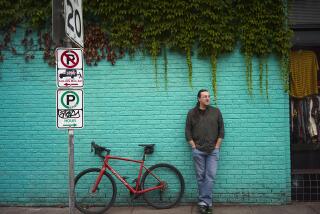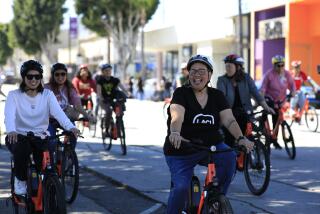Once a rider, now a ‘ghost bike’
NEW YORK — The well-trod sidewalk beside a busy urban boulevard is an unlikely place for a young man’s memorial, but there it is, chained to a signpost outside a furniture store: a man’s bicycle painted ghostly white. Flowers cover the frame and snake up the signpost, and a rust-colored shawl is tied carefully to the handlebars.
For months after her son Asif’s death on the adjacent street, Lizi Rahman would visit the bicycle at least twice a week. Sometimes she would stand in the middle of the wide, buzzing avenue and visualize Asif, 22, riding alongside the buses, trucks, cars and other cyclists.
“When I go there, it’s like I see him,” said Rahman, who still can’t believe that anyone could have missed her nearly 6-foot-tall son as he pedaled home one afternoon in February 2008. But a truck driver hit and killed Asif, and the so-called ghost bike erected in his honor is now one of nearly 70 in New York City, planted near the spots where riders were killed.
The practice began here in 2005 after 28-year-old Elizabeth Padilla died beneath the wheels of an ice cream delivery truck in Brooklyn. It was started two years earlier in St. Louis, where volunteers began erecting ashy white bikes to remember fallen cyclists. Now, there are ghost bikes in as many as 134 cities in 35 states and 21 countries, according to www.ghostbikes.org, which tracks the activities of the volunteer groups that maintain the bicycles.
Few have as many ghost bikes as New York, and as with most things that occupy precious public space in this overcrowded city, they have caught the attention of city officials. In June, the Department of Sanitation said it planned to remove “derelict” bikes, including ghost bikes, saying they denied other bicyclists parking spots and could block sidewalks or streets.
The department backed down this month after biking advocates argued that ghost bikes are memorials, not abandoned piles of steel. But people like Mary Beth Kelly, whose husband, Carl Henry Nacht, was killed while bicycling, said the battle showed the difficulties of getting the city to spotlight the hazards cyclists face, even as it encourages cycling and creates new bike lanes.
“We are trying to make New York a more livable city, and that means alternative means of transportation have to be made available and safe,” Kelly said. “These bikes serve as reminders that we’re only halfway there.”
The challenge of keeping growing numbers of bicyclists safe is not confined to New York, where commuter cycling has more than doubled since 2005. Los Angeles Mayor Antonio Villaraigosa broke his elbow in July when he crashed his bike while avoiding a taxi that pulled in front of him. City biking advocates said the incident underscored their demands for more bike lanes and better enforcement of laws to prosecute drivers who endanger cyclists.
According to ghostbikes.org, there are at least seven ghost bikes in Los Angeles, in addition to smaller collections of bikes in Newport Beach, San Clemente, San Diego, Bakersfield and Fresno. The latest Los Angeles ghost bike was erected in February 2010 in memory of Ovidio Morales, 34, who was hit and killed by a driver while riding his bike in Compton.
Nationwide, the bicycle fatality rate has topped 700 annually since 2004. In 2008, the last year for which figures are available, the number was 716, including 42 in New York and 109 in California, according to the National Highway Traffic Safety Administration.
Lizi Rahman hadn’t heard of the ghost bikes before her son was killed in New York, but now she views them as a way of raising awareness among pedestrians, cyclists and drivers. She still visits Asif’s ghost bike a couple of times a month, and she keeps an eye on it when she drives by to make sure it hasn’t been knocked over. She notices when someone has left flowers or other mementos.
The scarf appeared recently. “It’s nicely wrapped around the front,” Rahman said. “Someone who loves him, adores him, came and in his memory put a scarf around it.”
Such gestures are common for the ghost bikes that dot New York’s five boroughs. With their white frames and tires and garlands of flowers, the bicycles are startling amid the gray and black of the city streets. Passersby sometimes stop abruptly, then move closer to read the signs that accompany each one. Rahman and Kelly say the bicycles could save lives by reminding people of the hazards on New York’s crowded streets.
But not everyone who has lost a loved one to a cycling tragedy embraces them. The parents of 8-year-old Alexander Toulouse still try to avoid the Brooklyn intersection where their son was killed by a post office truck in 2008, and they declined the invitation to attend his ghost bike’s unveiling.
“Alexander Toulouse. 8 years old. Killed by truck. Sept. 6, 2008. Rest in peace,” the sign on the white children’s bicycle reads. On the anniversary of his death, someone left a cup filled with colored daisies on the sidewalk beside the bike.
“It is a good idea to highlight cycling fatalities,” Alexander’s father, Chris Toulouse, said in an e-mail, but he said ghost bikes were no substitute for the city making drivers more aware of bike lanes and making cyclists more diligent about obeying traffic rules. And for him and his wife, at least, they are more of a painful reminder than a pleasant memorial.
Though most ghost bikes are old and donated by bike shops, the bicycle memorializing Nacht is one the doctor used for commuting. It replaced the original donated ghost bike, which was smashed by a car even though it was off the street and beside a designated bike path that skirts the Hudson River in Manhattan.
Nacht and Kelly were pedaling along the popular path in June 2006 when a police tow truck turned onto the path from the street, hitting Nacht.
“That bike has particular meaning to me,” Kelly said of the current ghost bike, which she offered to volunteers after the first one was wrecked. Nacht would have turned 61 on Sept. 10, so Kelly did what she always does to memorialize his birthday: She visited his old bike and filled its basket with flowers.
But memories are only part of the reason Kelly says the ghost bike must remain. “It has a very important message, which is that cyclists even on a bike path cannot be protected enough,” said Kelly, who like Rahman was active in the campaign to preserve ghost bikes.
They are resting more easily now that sanitation officials have changed their tune, but Leah Todd of the Street Memorial Project said there could be battles ahead as the number of ghost bikes grows to match the number of bicyclists killed.
“I’m never confident that there will be a last fight,” Todd said.
Police, meanwhile, announced the death of another cyclist on Sept. 11: a 23-year-old woman run over by a city bus after being knocked off her bike by a driver who opened a car door into her path.
More to Read
Sign up for Essential California
The most important California stories and recommendations in your inbox every morning.
You may occasionally receive promotional content from the Los Angeles Times.










